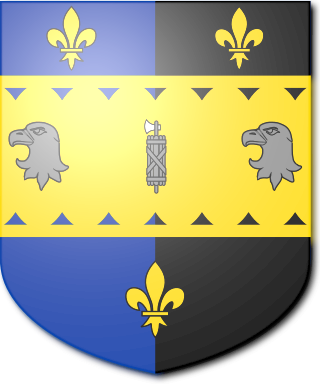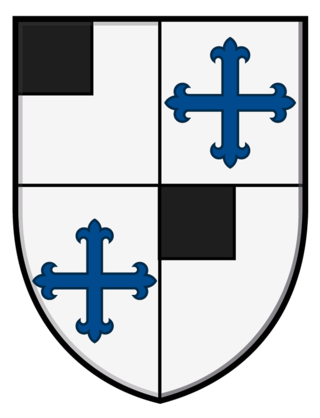
Viscount Hardinge, of Lahore and of Kings Newton in the County of Derby, is a title in the Peerage of the United Kingdom. It was created in 1846 for the soldier and Tory politician Sir Henry Hardinge. His son, the second Viscount, represented Downpatrick in Parliament. His great-great-grandson, the sixth Viscount, succeeded a distant relative as eighth Baronet, of Belle Isle in the County of Fermanagh, in 1986. This title had been created in the Baronetage of the United Kingdom 1801 for Richard Hardinge. He was the third son of Nicolas Hardinge, younger brother of Reverend Henry Hardinge and uncle of the latter's third son Henry Hardinge, 1st Viscount Hardinge. The baronetcy was created with special remainder to the heirs male of Richard Hardinge's father.
The Stronge baronetcy of Tynan was conferred in the Baronetage of the United Kingdom on 22 June 1803. The family were northern Irish landowners of Tynan Abbey, County Armagh, also possessing the residence of Lizard Manor, Aghadowey, County Londonderry.

The Austin Baronetcy, of Red Hill in the parish of Castleford in the West Riding of the County of York, is a title in the Baronetage of the United Kingdom. It was created on 16 July 1894 for John Austin, Liberal member of parliament for Osgoldcross.

The Anson baronetcy, of Birch Hall in the County Palatine of Lancaster, is a title in the Baronetage of the United Kingdom held by a branch of the Anson family. It was created on 30 September 1831 for William Anson. He was the third son of George Anson; his elder brothers were Thomas Anson, 1st Viscount Anson, and General Sir George Anson. Sir William was the uncle of Thomas Anson, 1st Earl of Lichfield, and Major-General George Anson and the great-nephew of George Anson, 1st Baron Anson. His grandson, the third Baronet, was a lawyer and Liberal Unionist politician. He never married and was succeeded by his nephew, the fourth Baronet. He was the only son of Frederick Arthur Anson, third son of the second Baronet. The fourth baronet drowned in the Thames on an outing of The Coterie in July 1914, after he jumped into the river encouraged by lady Diana Manners. He had not married and on his death the title passed to his first cousin, the fifth Baronet, the eldest son of Rear-Admiral Algernon Horatio Anson (1854–1913), fourth and youngest son of the second Baronet. He was killed in action in the First World War. He was unmarried and was succeeded by his younger brother, the sixth Baronet. His elder son, the seventh baronet, was a Rear-Admiral in the Royal Navy. As of 2021 the title is held by the latter's son, the eighth Baronet, who succeeded in 2018.

The Whitehead Baronetcy, of Highfield House in Catford Bridge in the County of Kent, is a title in the Baronetage of the United Kingdom. It was created on 26 November 1889 for James Whitehead, Lord Mayor of London between 1888 and 1889 and later member of parliament for Leicester. His younger son, the third baronet, was also a Member of Parliament.

The Blennerhassett Baronetcy of Blennerville in the County of Kerry, is a title in the Baronetage of the United Kingdom. It was created on 22 September 1809 for the Anglo-Irish lawyer Rowland Blennerhassett, He was from a family originally from Cumberland, England, that settled in County Kerry during the reign of James I and represented County Kerry and Tralee in the Irish House of Commons.

The Broadbent Baronetcy, of Longwood in the Parish of Huddersfield in the West Riding of the County of York, and of Brook Street, in the Parish of St George Hanover Square in the County of London, is a title in the Baronetage of the United Kingdom. It was created on 10 August 1893 for the noted physician William Broadbent. The title descended from father to son until the death of his grandson, the third Baronet, in 1987. The late Baronet was succeeded by his first cousin once removed, the fourth Baronet. He was the grandson of Walter Broadbent, third son of the first Baronet.

The Baynes Baronetcy, of Harefield Place in the County of Middlesex, is a title in the Baronetage of the United Kingdom. It was created on 29 June 1801 for Christopher Baynes. He was Major-Commandant of the Uxbridge Gentlemen and Yeomanry Cavalry, which he helped to raise. The title descended from father to son until the death of his great-great-grandson, the fifth Baronet, in 1971. The late Baronet died unmarried and was succeeded by his first cousin, the sixth Baronet. He was the son of Reverend Malcolm Charles Baynes, fourth son of the third Baronet. As of 2023 the title is held by his grandson, the eighth Baronet, who succeeded his father in 2005.

The Walsham Baronetcy, of Knill Court in the County of Hereford, was a title in the Baronetage of the United Kingdom. It was created on 30 September 1831 for John James Walsham. He received the baronetcy as the eldest co-heir and representative of Sir Thomas Morgan, 1st Baronet. The second Baronet was Envoy Extraordinary and Minister Plenipotentiary to China from 1885 to 1892 and to Romania from 1892 to 1893. The fourth Baronet was a rear admiral in the Royal Navy.

The Macgregor Baronetcy, of Savile Row in the County of Middlesex, is a title in the Baronetage of the United Kingdom. It was created on 17 March 1828 for Patrick Macgregor, Serjeant-Surgeon to King George IV. Charles Reginald Macgregor (1847–1902), second son of the third Baronet, was a Brigadier-General in the Army.

The Synge Baronetcy, of Kiltrough in the County of Meath, is a title in the Baronetage of the United Kingdom. It was created on 12 August 1801 for Robert Synge. The third Baronet served as High Sheriff of County Cork in 1844. The family surname is pronounced "Sing". As of 28 February 2014 the present Baronet has not successfully proven his succession and is therefore not on the Official Roll of the Baronetage, with the baronetcy considered dormant since 2011.

The Medlycott Baronetcy, of Ven House in the County of Somerset, was a title in the Baronetage of the United Kingdom. It was created on 3 October 1808 for William Medlycott, Member of Parliament for Milborne Port from 1790 to 1791. The family descended from James Medlycott, of Ven House, who represented Milborne Port in the House of Commons between 1710 and 1722. His son Thomas Medlycott died without surviving male issue in 1763 and left his estates to his maternal nephew Thomas Hutchings, who adopted the surname of Medlycott. His son was the first Baronet. The baronetcy became extinct with the death of the 9th Baronet in 2021.

The Price, later Rugge-Price Baronetcy, of Spring Grove in Richmond in the County of Surrey, is a title in the Baronetage of the United Kingdom. It was created on 2 February 1804 for Charles Price, Member of Parliament for the City of London from 1802 to 1812 and Lord Mayor of London from 1802 to 1803. The fifth Baronet assumed in 1874 by Royal licence the additional surname of Rugge. As of 28 February 2014 the present Baronet has not successfully proven his succession and is therefore not on the Official Roll of the Baronetage, with the baronetcy considered dormant since 2000.

The Wedderburn, later Ogilvy-Wedderburn Baronetcy, of Balindean in the County of Perth, is a title in the Baronetage of the United Kingdom created in 1803.
There have been three baronetcies created for personswith the surname Elphinstone, two in the Baronetage of Nova Scotia and one in the Baronetage of the United Kingdom. As of 2008 two of the creations are extant while one is dormant.

The Crofton Baronetcy, of Longford House in the County of Sligo, was created in the Baronetage of the United Kingdom on 18 August 1838 for James Crofton. He was descended from Thomas Crofton, uncle of the first Baronet of the 1661 creation.

The Sutton Baronetcy, of Norwood Park in the County of Nottingham, was created in the Baronetage of Great Britain on 14 October 1772 for the politician Richard Sutton. He was the second surviving son of the diplomat Sir Robert Sutton: who was the grandson of Henry Sutton, brother of Robert Sutton, 1st Baron Lexinton. In the late 19th and early 20th century, the family seat was at Benham Place. However, the house was sold in 1982.

The Campbell baronetcy, of Auchinbreck in the County of Argyll, was created in the Baronetage of Nova Scotia on 24 January 1628 for Sir Dugald Campbell. He was a descendant of Duncan Campbell of Kilmichael, younger son of Duncan Campbell, 1st Lord Campbell, ancestor of the Dukes of Argyll. The fifth Baronet was one of the Scottish representatives to the 1st Parliament of Great Britain.

The Campbell baronetcy, of Barcaldine in the County of Argyll and of Glenure, was created in the Baronetage of the United Kingdom on 30 September 1831 for the soldier Duncan Campbell.

The Baird baronetcy of Newbyth, second creation, in the County of Haddington, was created in the Baronetage of the United Kingdom on 13 April 1809 for the soldier David Baird, grandson of William Baird, a younger son of Sir Robert Baird, 1st Baronet, of Saughtonhall. His father, William Baird, had inherited the Newbyth estate in 1745 on the death of Sir John Baird, 2nd Baronet, of the 1680 creation. The baronetcy was created with remainder to Baird's elder brother Robert Baird and the heirs male of his body. Sir David Baird died childless and was succeeded, according to the special remainder by his nephew David Baird, the second Baronet. At the death of the 6th Baronet in 2022, his fourth cousin, Sir Andrew James Baird became the 7th Baronet in April 2023.



















